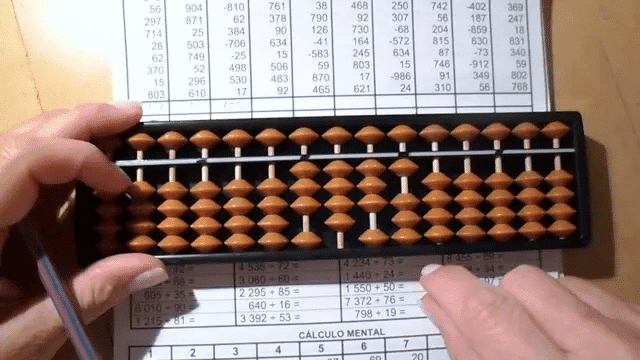Class 1 Exam > Class 1 Notes > Abacus > Worksheet Solution: Multiplication
Worksheet Solution: Multiplication | Abacus - Class 1 PDF Download

Instructions:
Imagine you have a Soroban abacus with beads. Each bead is worth 1. Use the abacus in your mind (or draw beads if you like) to solve these multiplication problems. Multiplication means adding a number to itself a certain number of times. Write your answers in the boxes!
- You have 2 beads, and you add them 2 times (2 × 2). How many beads in total?
Answer: ____
Answer: 4
Imagine 2 beads. Add another 2 beads (2 + 2). On the abacus, you’d see 4 beads. - Take 3 beads, and repeat them 2 times (3 × 2). How many beads are there?
Answer: ____
Answer: 6
Start with 3 beads. Add 3 more beads (3 + 3). You’ll have 6 beads on your abacus. - You have 1 bead, and you add it 3 times (1 × 3). What’s the total?
Answer: ____
Answer: 3
Picture 1 bead. Add 1 bead two more times (1 + 1 + 1). You’ll see 3 beads. - Take 4 beads, and repeat them 2 times (4 × 2). How many beads in all?
Answer: ____
Answer: 8
Imagine 4 beads. Add 4 more beads (4 + 4). Your abacus shows 8 beads. - You have 2 beads, and you add them 3 times (2 × 3). How many beads are there?
Answer: ____
Answer: 6
Start with 2 beads. Add 2 beads two more times (2 + 2 + 2). You’ll count 6 beads. - Take 5 beads, and repeat them 1 time (5 × 1). What’s the total?
Answer: ____
Answer: 5
Picture 5 beads. Since it’s just 1 time, you still have 5 beads on the abacus. - You have 3 beads, and you add them 3 times (3 × 3). How many beads in total?
Answer: ____
Answer: 9
Imagine 3 beads. Add 3 beads two more times (3 + 3 + 3). You’ll see 9 beads. - Take 2 beads, and repeat them 4 times (2 × 4). How many beads are there?
Answer: ____
Answer: 8
Start with 2 beads. Add 2 beads three more times (2 + 2 + 2 + 2). Your abacus shows 8 beads. - You have 4 beads, and you add them 1 time (4 × 1). What’s the total?
Answer: ____
Answer: 4
Picture 4 beads. Since it’s only 1 time, you keep 4 beads on the abacus. - Take 3 beads, and repeat them 4 times (3 × 4). How many beads in all?
Answer: ____
Answer: 12
Imagine 3 beads. Add 3 beads three more times (3 + 3 + 3 + 3). You’ll have 12 beads.
Bonus Fun: Draw an abacus with 6 beads to show 2 × 3!
Hint: Start with 2 beads, add 2 more, then 2 more, and show 6 beads total.
|
52 videos|82 docs|3 tests
|
FAQs on Worksheet Solution: Multiplication - Abacus - Class 1
| 1. What is multiplication, and why is it important for Class 1 students? |  |
Ans.Multiplication is a mathematical operation where we add a number to itself a certain number of times. For example, 3 multiplied by 2 (3 x 2) means adding 3 two times (3 + 3). It is important for Class 1 students as it lays the foundation for more advanced math concepts, helps in developing problem-solving skills, and is used in everyday life, such as in counting, sharing, and measuring.
| 2. How can parents help their child learn multiplication at home? |  |
Ans. Parents can help their child learn multiplication by using fun and interactive methods. They can use flashcards, multiplication games, and real-life examples like grouping objects (e.g., toys or fruits) to visualize multiplication. Encouraging children to practice with worksheets and apps designed for their age can also make learning enjoyable.
| 3. What are some effective multiplication strategies for Class 1 students? |  |
Ans.Some effective multiplication strategies for Class 1 students include using repeated addition, creating visual aids like arrays or groups, and utilizing multiplication songs or rhymes. Additionally, teaching them multiplication tables for numbers 1 through 5 can help them memorize basic facts more easily.
| 4. What are common mistakes Class 1 students make when learning multiplication? |  |
Ans.Common mistakes include confusing multiplication with addition, misremembering multiplication facts, and struggling to understand the concept of groups. Some children may also misinterpret word problems or fail to align numbers correctly in written calculations. It’s important for teachers and parents to provide guidance and encouragement to help them overcome these challenges.
| 5. How can teachers assess multiplication skills in Class 1 students? |  |
Ans.Teachers can assess multiplication skills through various methods such as oral quizzes, written tests, and hands-on activities. Observing students during group work or using games can also provide insight into their understanding. Additionally, teachers can use worksheets that focus on different multiplication concepts to evaluate progress and identify areas needing improvement.
Related Searches
















